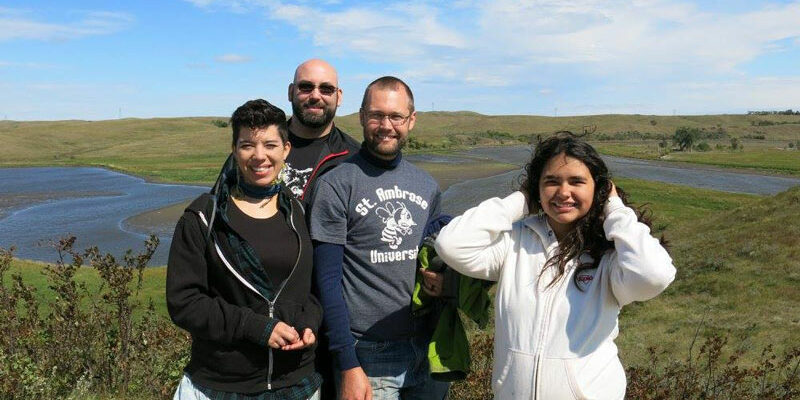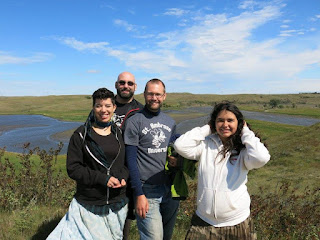Sacred Stone Camp: Spirit Come Alive
Nathan Holst is a youth minister, activist/organizer, and musician. With a background in social work (Concordia College in Moorhead), he is passionate about learning from and guiding youth in understanding the economic, social, and environmental crises of our time, focusing on the wisdom and life at the center of Christianity to engage fully in the world. Nathan lives in Duluth with his partner Sarah, and is a member of the Arrowhead Network of MNIPL.
Spirit come alive
Let us follow the current
Trace the sacred sighs
In the call of the earth
With seven generations
Standing before us now
May the Spirit come alive
These words from a song I wrote years ago were ringing in my ears this last weekend as I came with folks from the All Nations Indigenous Center in Duluth to join thousands of indigenous people at the incredible gathering at the Standing Rock Reservation to protect the water (and burial sites) from the Dakota Access Pipeline, slated to run just North of the reservation. There truly was an incredible Spirit coming alive in that space where elders, children, families were all tracing the call of the earth to protect the water for future generations.
Here is a picture of what it’s like there: the front line camp is right off the main highway, situated right next to a river. When you first enter, you see signs that clearly mark “No drugs, no alcohol, no weapons”. It is a space for families (of which there were countless) and a space of nonviolence (which was made clear to us again and again in our time there). As you continue on, there are flags from every nation represented flying high, which was reported to me to be between 90 and 150. Then there is the check-in tent, a tent for donations, a tent for media, and the main circle gathering space where there are constantly speakers sharing their story with anyone gathered to hear. At night, this space is filled with musicians and spoken word artists, ready to lift each other up with their songs and words. Drum ceremonies and sweat lodges run constantly. Both by day and night you can find people gathered in their small, spread out camps based on tribal affiliation, but porous as family, always intermingling with each other. There are elders telling stories and making jokes, people sharing meals together, and building family as well as a movement.
As reported (best, in my estimation, by Democracy Now), on Saturday afternoon, shortly before we arrived there was a group of peaceful protectors who stood in front of bull dozers to stop them from destroying burial sites where the people managing the Dakota Access Pipeline knew there were burial grounds and still chose to dig. In some news outlets, this has been reported as protestors attacking security guards, when the story from Indigenous folks is that they were peacefully trying to stop them from destroying their graves, only to have dogs unleashed on them, as well as pepper spray. And as the Huffington Post asked, “How would you feel if a construction company bulldozed a family plot in a local cemetery that contained the remains of your family?” These are courageous men, women, and children that know what they are willing to fight for and stand in the way of the violence being done to their ancestors, being done to our water.
On Sunday, we marched with 500 people on the highway to the edge of where the graves had been unearthed. We gathered in a huge circle for a ceremony for the ancestors who had been disturbed, where all the spiritual men and women leaders were called to the center. Singers began, followed by medicine men praying to the four directions, as well as dancers joining in this incredible prayer for the ancestors. It was like nothing I’d ever experienced, and as I was filled with awe and wonder at what was happening, I tried to imagine if I felt this way as a white person, what might all the indigenous folks who are there feel? So many of those who came with us from Duluth said at the end of the trip, speaking through their tears, “I feel home”.
So after leaving what then felt like family and returning to Duluth, I am back here wrestling with fire in my belly, which I see as the longing for justice for my relatives, and showing up in the best way I know how, trying to share what I experienced with my community. I am trying to get the word out to everyone I know, especially since many newspapers are either not picking up this incredible story or distorting the perspectives of those at the camp.
But I am also caught with a vision. I have seen, tasted the incredible culture of elders, spiritual leaders, nonviolent warriors, and families and I can’t help but wonder: where are my people? Where are my elders? What would it look like for my white community to have this kind of powerful gathering to protect our water? I heard African Americans speaking to their history, acknowledging the help they received from Indigenous people to escape slavery. Now they’re showing up to support them in this movement and putting their lives on the line in gratitude. Is there someone in my white community that can speak in this way, to share gratitude for when indigenous people welcomed them to this land, even when we repaid hospitality with brutality? Is there a path for us to regain our humanity and to have this same kind of historical clarity, to recognize our place in this great story?
I believe we have an invitation in front of us. There is an incredible gathering of tribes from across this land (and the world) standing up and protecting our water that gives us life. What is the legacy that we want to leave? What story do we want to give those who come seven generations after us? Though life can often be complex and simple answers sometimes elude us, the choice is still right in front of us, and those who come after us are waiting to see what we will do.


